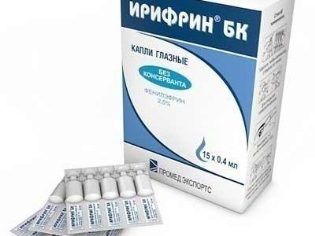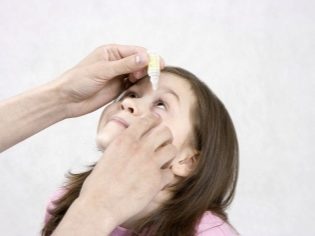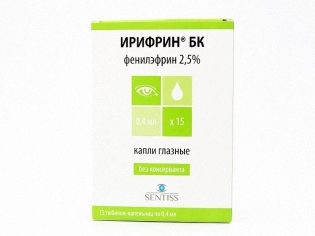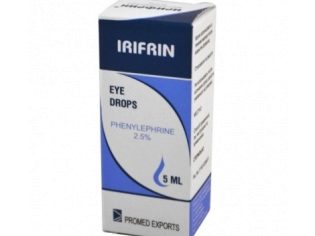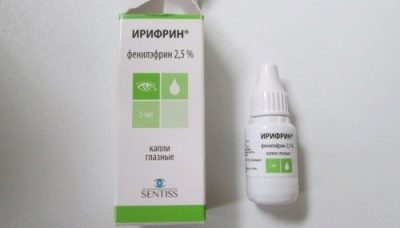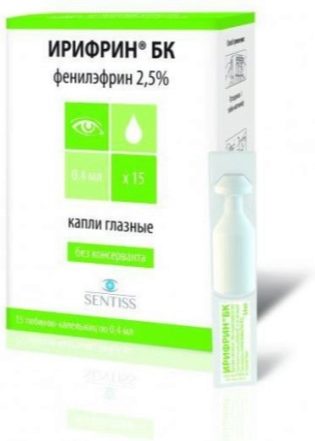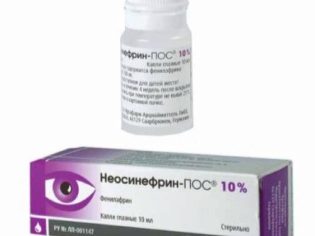Eye drops "Irifrin BK" for children
In ophthalmology, local medicines are most commonly used in the form of eye drops. If you want to expand the pupil or affect the vessels of the eye, apply alpha-adrenomimetics, one of which is Irifrin. A preservative-free drug called Irifrin BK is produced especially for children. When is it prescribed to a child and at what dosage is it dripping?
Release form
The drug is represented by a clear liquid, which has a light yellow color, but it can also be colorless. The solution is placed in a disposable tube-dropper in the amount of 0.4 ml in each. Five of these tubes are packed in a laminated bag, and one cardboard box includes 3 bags, that is, a total of 15 tubes are in the package.
Composition
The active substance in the droplets is represented by phenylephrine in the form of hydrochloride. Since the solution has a concentration of 2.5%, then one milliliter contains 25 mg of phenylephrine. Addition to this ingredient are hypromellose, citric acid and edetate disodium. As part of the medication and water for injection, sodium metabisulfite and sodium citrate dihydrate sodium.
Operating principle
The drug is a group of sympathomimetics that affect alpha-adrenergic receptors. For ophthalmologists, such local effects of Irifrin, such as narrowing of blood vessels in the conjunctiva, dilated pupil and stimulation of outflow of intraocular fluid, are important.
With a sufficiently strong effect on the alpha receptors of the eyes, the drug has almost no effect on the beta receptors located in the heart. Pupil dilation can be observed in a patient 10-60 minutes after contact of phenylephrine on the conjunctiva. The effect of the drug lasts up to two hours.
Indications
Drip Irifrin BC in the eyes recommend:
- For diagnostic procedures requiring pupil dilation.
- For the treatment of iridocyclitis.
- With redness and irritation of the eyes.
- With a high visual load, to prevent accommodation spasm and asthenopia.
- To relieve spasm of accommodation, as well as to stop progressive myopia.
At what age is it allowed to take?
Annotation to the drops does not indicate any age restrictions, but the use of the drug in children under one year old should be only under the supervision of a physician.
And now we offer you to watch a video of how to put eyes on a child.
Contraindications
The drug is not used:
- If the child has hypersensitivity to any component of the drops.
- If closed or narrow-angle glaucoma is diagnosed.
- If a patient has high blood pressure, tachycardia or arrhythmia is detected.
- With diabetes.
- If the body weight of the newborn is too low.
- If the child has hyperthyroidism.
- With a lack of glucose 6 phosphate dehydrogenase.
- In violation of the integrity of the eye.
- With violations of the production of tears.
Caution for treatment with Irifrin is required for sickle-cell anemia or bronchial asthma, as well as after surgery in the eye area, since such a drug will interfere with healing.
Side effects
The use of drops can cause such local reactions as burning sensation, swelling in the eye area, inflammation of the conjunctiva, increased intraocular pressure, blurred vision, increased discharge of tears, redness, and others. It is also possible the appearance of a reactive dilation of the pupil the day after the use of the drug.
In some patients, Irifrin BK can cause dermatitis. In addition, the drug can adversely affect the cardiovascular system, which is manifested by tachycardia, increased blood pressure, arrhythmia, and other signs.
Instructions for use and dosage
- If an ophthalmoscopy is performed, then you need to insert 1 drop of medication once into the conjunctival sac and wait 15-30 minutes before the examination, and if necessary, prolonged dilation of the pupil after 1 hour, reapply the eye.
- When treating iridocyclitis, the drug is dripped two or three times a day, one drop for 5-10 days. More precisely, the duration of therapy is determined by the physician based on the severity of the disease.
- School children with weak myopia are recommended to use prophylactic Irifrin BK one drop in each eye during the period of high visual stress. The drug is used before bedtime.
- If a child has an average degree of myopia and the disease progresses, regular prophylactic use at bedtime three times a week, 1 drop, is prescribed.
- When treating myopia (both true and false), a child is prescribed Irifrin BK for 1 month. The drug is dripped at night 2 or 3 times a week for 1 drop.
Overdose
A very high dose of drops affects the child's behavior (he becomes nervous, restless), the heartbeat (it becomes more frequent) and breathing (it becomes weaker). Perhaps the appearance of vomiting, complaints of dizziness, increased sweating. To eliminate these symptoms of overdose, adrenoceptor blocking agents are used, for example, phentolamine.
And now we offer a video release of the program on eye diseases from Dr. Komarovsky about children's conjunctivitis.
Interaction with other drugs
- The drug is not recommended to be combined with antihypertensive drugs and tricyclic antidepressants. It is also incompatible with monoamine oxidase inhibitors.
- If drip Irifrin BK together with atropine, it will increase the effect of the expansion of the pupil. However, due to exposure to blood vessels, this combination of drugs can cause tachycardia. A similar effect will be in a situation where Irifrin and Midriacil are used simultaneously.
- If local anesthetics are instilled into the eyes before using Irifrin, this will enhance the absorption of the drug into the bloodstream and its systemic effects, as well as prolong the period of pupil dilation.
Terms of sale and storage
The product is sold in a pharmacy by prescription, and the price of one package is on average 550-580 rubles. At home, it is advised to store the solution at a temperature of from 0 to 25 degrees Celsius. For storage, choose a place protected from direct sunlight where there is no access for small children. Shelf life drops - 2 years. It is impossible to store the opened tube, immediately after instillation, the rest of the medicine and the opened package are thrown away.
Reviews
Moms, whose children have been prescribed Irifrin for myopia or other vision problems, speak mostly well about the medicine. They confirm the efficacy of the drug and the rapid appearance of improvements after its use - increasing visual acuity, eliminating redness, and disappearing eye discomfort. Negative drug reviews are rare and include complaints about side effects or intolerance.
Analogs
Replace Irifrin BK with Vizofrin, Vizin, Neosinefrin-POS and others. However, they differ in composition and contraindications, so the choice of analogue requires consultation with an ophthalmologist.

